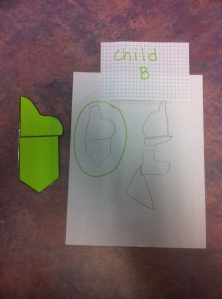 It was so exciting to see Mrs. Hollman’s grade 1-2 class fully engaged in a geometry lesson about 2-D shapes. I had taken in my Shape Sets (which I have discussed before in a previous blog) and used those as the basis of the lesson with the children.
It was so exciting to see Mrs. Hollman’s grade 1-2 class fully engaged in a geometry lesson about 2-D shapes. I had taken in my Shape Sets (which I have discussed before in a previous blog) and used those as the basis of the lesson with the children.
We first sat in a circle and talked about some different shapes. I held up different shapes one at a time and asked students to tell what they knew about or how they could describe each one. For some shapes the children had specific names (triangle, rectangle, etc.) but we developed some new vocabulary as well (such as hexagon, pentagon, octagon, vertex, edges, etc.). I even went to far as to drop some deeper thinking into the lesson by saying, “every square is a rectangle, but not every rectangle is a square.” That puzzled most of them, so I went on to say, “Every boy is a human, but not every human is a boy.” After saying that a couple of times I had many nods of agreement, so I said the square/rectangle one again. A few light bulbs went on 🙂
 Next, while we were still in the circle, I passed out one shape from the set to each student. I then would hold a shape up and say something like, “My shape has three sides (or a curve, or more than four sides, etc). Does yours?” and students with corresponding shapes would hold them up.
Next, while we were still in the circle, I passed out one shape from the set to each student. I then would hold a shape up and say something like, “My shape has three sides (or a curve, or more than four sides, etc). Does yours?” and students with corresponding shapes would hold them up.
Finally I modeled what the students were going to do at their desks. I used two shapes from the set and put them together on the board with magnets so they were touching. We talked about noticing where the two shapes touched and the directionality of the lines. Line by line I drew an image of the two shapes, asking questions of the class before I drew each line. Their task, I explained to the students, was to draw as carefully as possible a pair of two shapes. Students were instructed to lay the pieces on their desks, NOT on their paper, since they were not to trace the shapes, but to draw them as best they could. The students each took their one shape to their desks were they found a second shape waiting for them.
As there were several teachers in the classroom observing the lesson and who would be interacting with the students as they worked individually, I gave each teacher some of the extra shapes with the intention that once a student drew his pair of shapes, he could raise his hand, have a teacher comment on the drawing, and then exchange one of his shapes for a new one and repeat the process.
 As you can see from the samples I have uploaded, the students did a good job of representing their pairs of shapes. Almost all of the students were able to complete three or more drawings in the given time. Most children drew the shapes relatively close to actual size, while a few had real difficulty with that (child C, for example, had difficulty with that). The students were very engaged throughout the lesson, and we were able to lay the foundation for learning many new geometric words.
As you can see from the samples I have uploaded, the students did a good job of representing their pairs of shapes. Almost all of the students were able to complete three or more drawings in the given time. Most children drew the shapes relatively close to actual size, while a few had real difficulty with that (child C, for example, had difficulty with that). The students were very engaged throughout the lesson, and we were able to lay the foundation for learning many new geometric words.
I hope you try some shape drawing with your young students.
Download the Shape Set here.
Mathematically yours,
Carollee
PS: May I make a point here of saying that so many times we do not use proper terms with young children, thinking that the terms are “too difficult” for them to learn. Not so!! They will learn and come to use the vocabulary that is modeled for them, so please use lots of good math vocabulary. Even if it all does not “stick” you are laying the ground for “prior knowledge” for the next time they hear the terms.

 It was wonderful to share the Friday morning session at the Calgary City Teachers’ Conference with so many new friends! I hope you walked away with some ideas for helping your students understand mathematics is a deeper way. Congratulations to Shannon Muir who won the math coaching session in the draw!
It was wonderful to share the Friday morning session at the Calgary City Teachers’ Conference with so many new friends! I hope you walked away with some ideas for helping your students understand mathematics is a deeper way. Congratulations to Shannon Muir who won the math coaching session in the draw!




